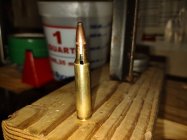Wolfdog91
Silver $$ Contributor
Quick question. For you guys using the deal where you take a pice of brass cut the neck long ways so you can squeeze it to hold you bullet but still let it move so you can measure you CBTO/COAL , how are you doing your brass before cutting ? Like do you just fireform and that's it ? Or to you for from them resize it the same way you would if you where reloading it for that gun ?
Thanks !

Thanks !













